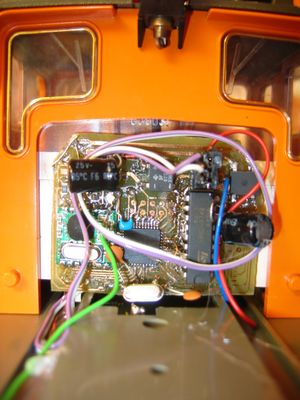Locodoco: Unterschied zwischen den Versionen
K (section break) |
Soeren (Diskussion | Beiträge) |
||
| Zeile 22: | Zeile 22: | ||
== Features == | == Features == | ||
=== Waypoints & Positioning information === | === Waypoints & Positioning information === | ||
Waypoints along the track (turnouts) transmit an unique ID via infrared diodes to bypassing locos. This allows locos to transmit their position, direction and speed to the controlling devices. It may also be possible to utilize | Waypoints along the track (turnouts) transmit an unique ID via infrared diodes to bypassing locos. This allows locos to transmit their position, direction and speed to the controlling devices. It may also be possible to utilize an accelerometer for more precise acceleration, deceleration information and positioning. | ||
=== Independent power supply === | === Independent power supply === | ||
Version vom 1. Juli 2009, 00:19 Uhr
| locodoco Release status: experimental [box doku] | |
|---|---|
| Description | An open source model railroad control infrastructure. |
| Author(s) | Soeren |
| Platform | AVR Microcontrollers |
| License | GPL |
Locodoco is an open source (Soft- and Hardware) project that lets you control model trains and automate train movements. The Project consist of several Hard- and Software components. In the first stage of this project's development a "loco decoder" was built. This piece of hardware lets you control motor throttle, lights and other functions of a loco via data transmissions.
Motivation
There simply wasn't an open implementation that suited my needs. There is a well-developed open source project that implements DCC (Open DCC). Unfortunately DCC doesn't provide features like sending transmissions from locos to the controller - well, actually it does, but DCC's feedback functions are quite limited due to DDC's nature.
Another goal I want to achieve is simplicity. A typical use case for this system is a plug-and-play setup where you simply stick all the track pieces together and plug in the power. In current implementations this works as well - turnouts get their signal from the track just like the locos do. The only disadvantage is that you'll have to remember or note turnout numbers in your control panel. The ability I wanted to add to model railroading is to make the process of switching a turnout more intuitive. Once this system is fully implemented you'll be able to select the next turnout on the way of a loco.
Features
Waypoints & Positioning information
Waypoints along the track (turnouts) transmit an unique ID via infrared diodes to bypassing locos. This allows locos to transmit their position, direction and speed to the controlling devices. It may also be possible to utilize an accelerometer for more precise acceleration, deceleration information and positioning.
Independent power supply
Unlike usual systems, locos equipped with a locodoco controller can run on any track that provides between 8 and 30 Volts power AC and DC. It is possible to mix usual DCC systems with this system and have locodoco equipped locos run on DCC powered track. The only disadvantage is that you can't control DCC locos with controllers for the locodoco system. It should be possible to let locodoco Trains accept commands from DCC, though this is a question of software development - the hardware is ready for it ;)
Loco decoder
The loco decoder consists of an AVR Microcontroller (Atmega32), a RFM12 radio transceiver, an L6202 Motor controller and several other Parts. Due to its size (3x5cm), it currently only fits into rather large scale Trains (i.e. G-Scale locos). At the moment the parts used are mostly SMD and the copper layout is designed for a one-sided board. It may be possible to shrink the entire size to 1/2 of the current, but that'll be pretty much the end of the scale and could fit into normal-sized H0 locos at most.
Waypoint transmitter
A waypoint transmitter consists of a tiny AVR microcontroller that continuously transmits the same sequence of bits while it is turned on. An infrared LED connected to one of the AVR's output drivers can be installed in turnouts and normal track to mark a position.
Turnout controller
The turnout controller is a piece of hardware that... well, controls turnouts. There will be several different versions available - some with RFM12 modules, some with infrared transistors to receive commands. Both with different amounts of outputs (for driving more than one turnout or n-way turnouts).
State of the Project
Done so far
- Loco decoder Prototype board built & tested in LGB 2033 and 2060
- First decoders installed and proven to be working stable
- First pieces of software tested and run
- Finished work bootloader to wirelessly update the firmware of the controller
To be done
Basic stuff
- Develop a turnout controller (Hard- and Software)
- Develop track nodes (for positioning information)
- Develop a controlling device (currently a simple piece of software on a pc)
Nifty stuff
- Implement automatic track setup detection (i.e. let a loco drive along the track and scan all waypoints). This is necessary to enable the selection of the next turnout stage.
- Experiment with accelerometer track recognition and 3D stuff (i.e. having live position data in opengl)
